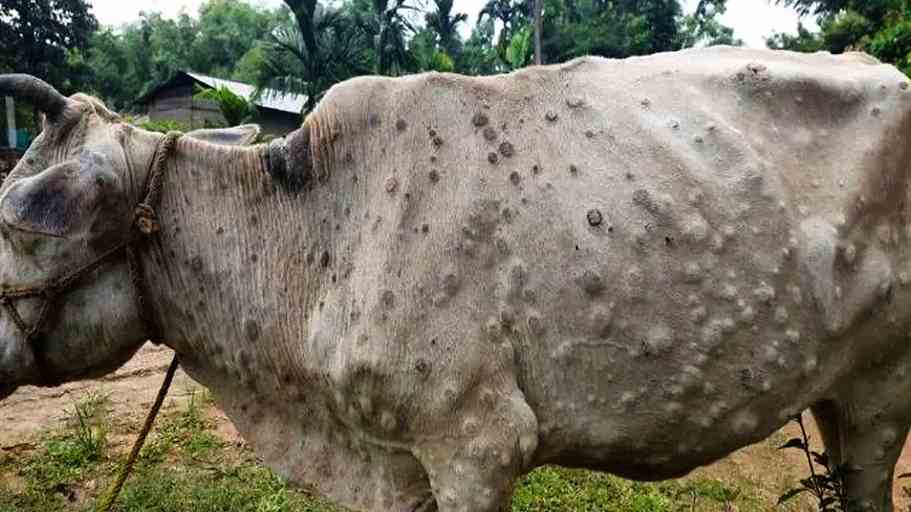
Introduction
Lumpy skin disease (LSD) caused by the lumpy skin disease virus (LSDV) is an OIE notifiable, vector-borne disease of cattle and Asian water buffalo that causes substantial economic losses. Its name originates from the clinical presentation of the disease generally associated with the appearance of skin nodules that may cover the entire body of the animal during severe infection. While mortality rates in cattle are often low, the relatively high morbidity of LSD once introduced into naïve populations can lead to significant income losses for farmers brought about by decreased milk production, damaged hides, emaciation of animals, infertility, and abortions. Subsequent trade bans or other movement restrictions in affected countries place an economic strain on the cattle industry, severely impacting all actors along the value chain.
Since the first observation of the disease in Zambia in 1929, LSD has spread progressively and extensively throughout Africa, the Middle East, South-eastern Europe, Central Asia, and more recently South Asia and China. Currently, the disease is endemic in several countries across Africa, parts of the Middle East (Iraq, Saudi Arabia, Syrian Arab Republic), Turkey, and India.
History
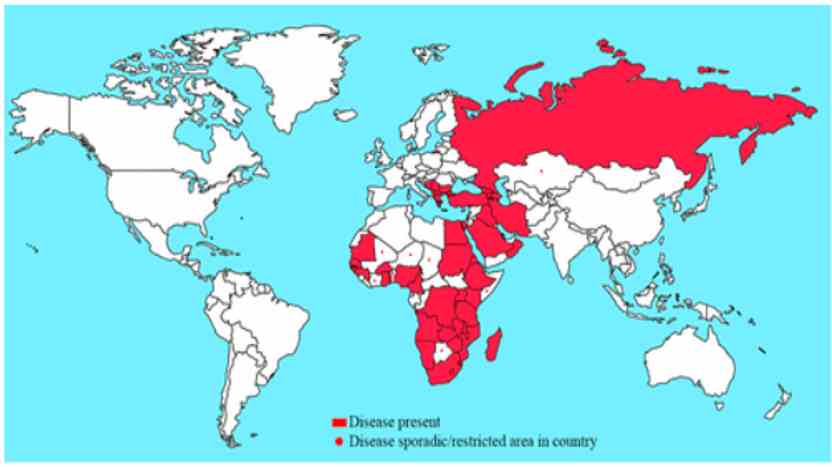
Lumpy skin disease was first seen as an epidemic in Zambia in 1929. Initially, it was thought to be the result of either poisoning or hypersensitivity to insect bites. Additional cases occurred between 1943 and 1945 in Botswana, Zimbabwe, and the Republic of South Africa. Approximately, 8 million cattle were affected by a panzootic infection in South Africa in 1949, causing enormous economic losses. LSD spread throughout Africa between the 1950s and 1980s, affecting cattle in Kenya, Sudan, Tanzania, Somalia, and Cameroon.
In 1989 there was an LSD outbreak in Israel. This outbreak was the first instance of LSD north of the Sahara Desert and outside of the African continent. This outbreak was thought to be the result of infected Stomoxys calcitrans being carried on the wind from Ismailiya in Egypt. During a period of 37 days between August and September 1989, fourteen of the seventeen dairy herds in Peduyim became infected with LSD. All of the cattle as well as small flocks of sheep and goats in the village were slaughtered.
Throughout the past decade, LSD occurrences have been reported in Middle Eastern, European, and west Asian regions.
Epidemiology Of Lumpy Skin Disease
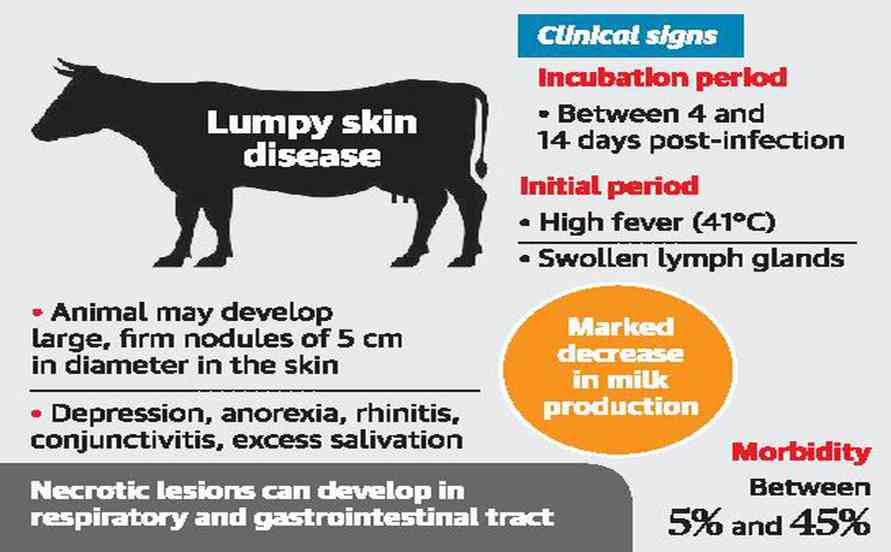
- LSD is prevalent in most African countries, notably in the Sub-Saharan area. It extended to South-East Europe, the Balkans, the Caucasus, Russia, and Kazakhstan after 2012. Field outbreaks may be severe and widespread infections with high rates of morbidity and mortality, while others may have few affected animals and few or no reported deaths. But in general, outbreaks are more severe when the infection is first introduced to a region and then decreased, most likely due to the development of widespread immunity. Morbidity rates during epizootics approach 80% but are closer to 20% in endemic areas.
1. Hosts and susceptibility
The LSDV belongs to the genus Capripoxvirus within the Poxviridae family and shares high antigenic similarities with the sheep pox virus (SPPV) and the goatpox virus (GTPV), two other members of this genus. While SPPV and GTPV serologically cross-react with LSDV, they do not cause disease in species other than their respective host.
LSDV is highly host-specific (domestic cattle and water buffaloes) with the exception that some strains may replicate in sheep and goats. However, no epidemiological investigations have found small ruminants to be viral reservoirs as of yet. Domestic cattle and Asian water buffalo are the most vulnerable animals during LSD outbreaks in the field. Some wild animals, such as the giraffe (Giraffe Camelopardalis) and the impala (Aepyceros melampus), are also vulnerable to experimental infection, but their role is unknown. Rather than the virus’s virulence, the host animal’s susceptibility is determined by its immunological state, age, and breed.
2. Sources of the virus
- Nodules that occur on the mucous membranes of the eyes, nose, mouth, rectum, udder, and genitalia also ulcerate and release enough viruses which can serve as sources of the virus. Approximately half of the infected animals may develop clinical signs; the majority of experimentally infected animals will become viremic and a source of the virus. LSD virus was found in saliva for 11 days, semen for 22 days, and skin nodules for 33 days in experimentally infected cattle, but not in urine or faces. Because Capripoxviruses are very resistant to physical and chemical conditions, they may survive in lesions or scabs for extended periods of time and have a great affinity for dermal tissues.
Transmission Of Lumpy Skin Disease
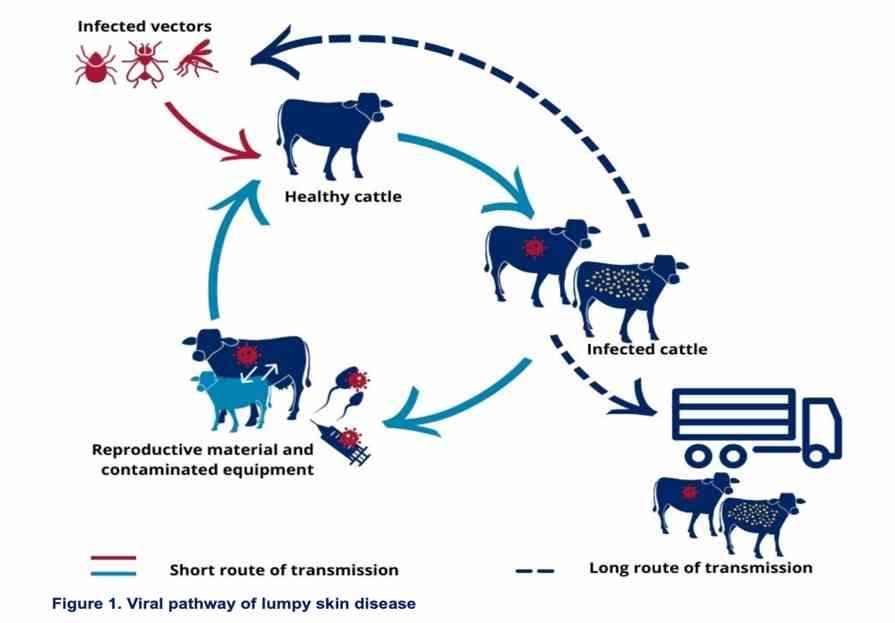
Outbreaks of LSDV are associated with high temperature and high humidity It is usually more prevalent during the wet summer and autumn months, especially in low-lying areas or near bodies of water, however, outbreaks can also occur during the dry season. Blood-feeding insects such as mosquitos and flies act as mechanical vectors to spread the disease.
A single species vector has not been identified. Instead, the virus has been isolated from Stomoxys, Biomyia fasciata, Tabanidae, Glossina, and Culicoides species. The particular role of each of these insects in the transmission of LSDV continues to be evaluated. Outbreaks of lumpy skin disease tend to be sporadic since they are dependent upon animal movements, immune status, and wind and rainfall patterns, which affect the vector populations.
The virus can be transmitted through blood, nasal discharge, lacrimal secretions, semen, and saliva. The disease can also be transmitted through infected milk to suckling calves. In experimentally infected cattle, LSDV was found in saliva 11 days after the development of fever, in semen after 22 days, and in skin nodules after 33 days. The virus is not found in urine or stool. Like other pox viruses, which are known to be highly resistant, LSDV can remain viable in infected tissue for more than 120 days.
LSDV can be transmitted by various blood-feeding arthropods but is not known to replicate in vectors. Therefore, transmission is mechanical but not biological in nature.
Potential vectors studied to date:
- Mosquitos: Aedes aegypti, Anopheles stephensi, Culex quinquefasciatus
- Flies: Stomoxys calcitrans, Haematobia irritans, Prostomoxys sp., Haematopota spp., Biomyia fasciata
- Midges: Culicoides nubeculosus
- Ticks: Rhipicephalus appendiculatus, Rhipicephalus decoloratus, Amblyomma hebraeum.
Symptoms Of Lumpy Skin Disease
Initial symptoms – Lachrymation and nasal discharge
Subscapular and prefemoral lymph nodes become enlarged and are easily palpable.
High fever (>40.50C) may persist for approximately a week.
The sharp drop in milk yield.
The appearance of highly characteristic, nodular skin lesions of 10-50 mm in diameter: The number of lesions varies from a few in mild cases to multiple lesions in severely infected animals. Predilection sites are the skin of the head, neck, perineum, genitalia, udder, and limbs. Skin nodules may persist for several months.
Sometimes, painful ulcerative lesions develop in the cornea of one or both eyes, leading to blindness in the worst cases.
Pneumonia caused by the virus itself or secondary bacterial infections, and mastitis are common complications.
Infected animals often recover within three weeks of treatment with anti-allergy and antibiotic medicines. The morbidity rate in LSD is 10-20%, while the mortality rate is up to 5%.
Prevention And Control
- Animals suspected of LSD should be isolated, and the farm should be quarantined until a definitive diagnosis is determined.
1. Disinfection
LSD virus is susceptible to ether (20%), chloroform, formalin (1%), and some detergents (sodium dodecyl sulphate), as well as phenol (2% for 15 minutes). It can survive for long periods in the environment – up to 35 days in desiccated scabs and 18 days in air-dried hides.
2. Control and Eradication
Outbreaks can be eradicated by quarantines, depopulation of infected and exposed animals, proper disposal of carcasses, cleaning and disinfection of the premises, and insect control. The most likely way for LSD to enter a new area is by the introduction of infected animals. Biting insects that have fed on infected cattle may travel or be blown for substantial distances. It is believed that LSD spread to Israel via contaminated insects that were blown across the Sinai Desert. The movement of contaminated hides represents another potential means for transmission.
3. Vaccination
In endemic areas, vaccination against LSD has been successfully practiced. Vaccines were helpful in eradication during an outbreak in Israel. In the Union of South Africa, an attenuated LSD vaccine is used. Vaccination with the Neethling strain confers immunity for up to 3 years. In Kenya and Egypt, the Romanian strain of sheep and goat pox vaccine has been used successfully for prophylaxis against LSD. Sheep pox vaccine may cause local, sometimes severe, reactions and is not advised in countries that are free from sheep and goat pox.
Diagnosis Of Lumpy Skin Disease
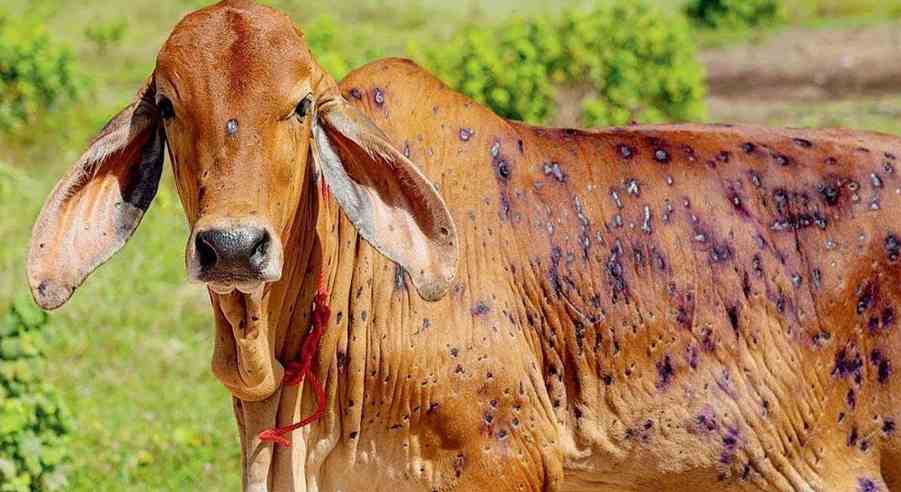
- LSD can be suspected when characteristic skin nodules, fever, and swollen lymph nodes are seen. Confirmation of lumpy skin disease in a new area requires virus isolation and identification. Antigen testing can be done using direct immunofluorescent staining, virus neutralization, or ELISA. Typical capripox (genus) virions can be seen using transmission electron microscopy of biopsy samples or desiccated crusts. This finding, in combination with a history of generalized nodular skin lesions and lymph node enlargement in cattle, can be diagnostic. Serological tests include an indirect fluorescent antibody test, virus neutralization, Western blot, and ELISA. Cross-reactions may occur with other poxviruses.
Immunity
1. Artificial Immunity
There have been two different approaches to immunization against LSDV. In South Africa, the Neethling strain of the virus was first attenuated by 20 passages on the chorio-allantoic membranes of hens’ eggs. Now the vaccine virus is propagated in cell culture. In Kenya, the vaccine produced from sheep or goatpox viruses has been shown to provide immunity in cattle. However, the level of attenuation required for safe use in sheep and goats is not sufficient for cattle. For this reason, the sheeppox and goatpox vaccines are restricted to countries where sheeppox or goatpox is already endemic since the live vaccines could provide a source of infection for the susceptible sheep and goat populations.
To ensure adequate protection against LSDV, susceptible adult cattle should be vaccinated annually. Approximately, 50% of cattle develop swelling (10–20 millimetres (1⁄2–3⁄4 in) in diameter) at the site of inoculation. This swelling disappears within a few weeks. Upon inoculation, dairy cows may also exhibit a temporary decrease in milk production.
2. Natural Immunity
Most cattle develop lifelong immunity after recovery from a natural infection. Additionally, calves of immune cows acquire maternal antibodies and are resistant to clinical disease until about 6 months of age. To avoid interference with maternal antibodies, calves under 6 months of age whose dams were naturally infected or vaccinated should not be vaccinated. On the other hand, calves born from susceptible cows are also susceptible and should be vaccinated.
- Animals infected with the LSD virus generally recover. Complete recovery may take several months and may be prolonged when secondary bacterial infections occur. Treatment is directed at preventing or controlling the secondary infection. It may take up to 6 months for animals severely affected by the LSD virus to recover fully. Administration of antibiotics to control secondary infection and good nursing care are recommended.
3. Treatment
- Animals infected with the LSD virus generally recover. Complete recovery may take several months and may be prolonged when secondary bacterial infections occur. Treatment is directed at preventing or controlling the secondary infection. It may take up to 6 months for animals severely affected by the LSD virus to recover fully. Administration of antibiotics to control secondary infection and good nursing care are recommended.
The Economic Impact Of Lumpy Skin Disease
The world organization for animal health (OIE) categorizes LSD as a notifiable disease due to its economic impact. LSD has been considered an agro-terrorism agent due to its ability to spread from Africa to other parts of the world. The economic implications of the disease are high due to morbidity rather than mortality, as the mortality rate is usually low.
Significant losses are due to severe emaciation, hide damage, infertility in males and females, mastitis, drop in milk production, and abortions.
Due to the reduction in the quality of the animals, the effect can be seen in the overall trade of live animals and animal products. This may cause huge financial losses to the meat industry, milk industry, leather industry, and other industries associated with livestock and its by-products. Not only industries, but poor farmers holding the livestock have to suffer the crisis due to the disease.
Lumpy Skin Disease In India
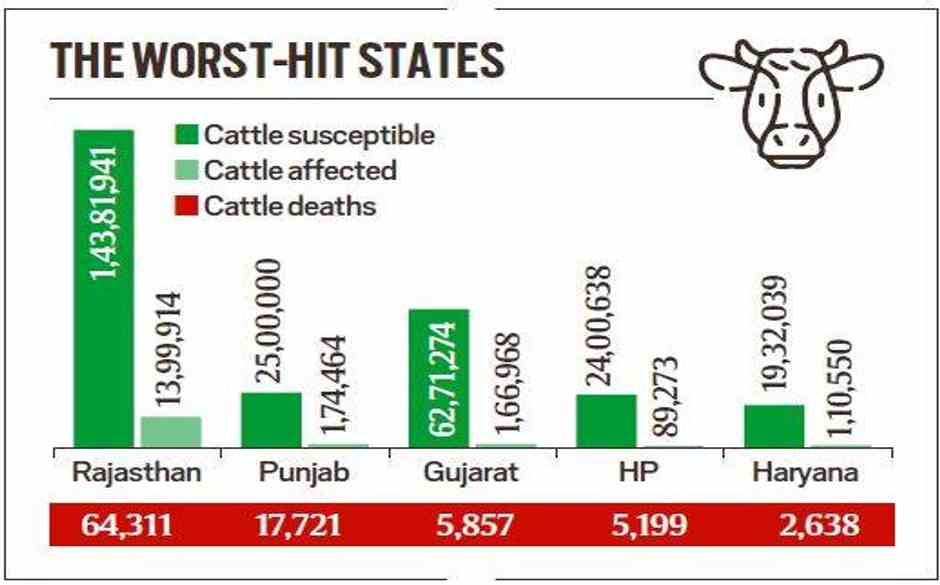
The first case of the Lumpy Skin Disease was reported in April in Gujarat’s Kutch region and since then the outbreak has spread, through India including in the states of Himachal Pradesh, Maharashtra, Jharkhand, Jammu and Kashmir, Uttar Pradesh, and Punjab, among others. Delhi has over 200 cases of the infection and most cases have been detected in the southwest Delhi districts — Goyla dairy area, Rewla Khanpur area, Ghumanhera, and Najafgarh.
In three months, over 80,000 bovines had died by September 2022.
In July 2022, the outbreak spread in 14 out of 33 districts of Gujarat state of India; by 25 July, more than 37000 cases and 1000 deaths in cattle were reported. As of 1 August 1200, bovines deaths and more than 25,000 cases were reported in Rajasthan.
Milk collection across Rajasthan is estimated to have been reduced by 3 to 4 lakh liters per day after the onset of lumpy skin disease. According to Rajasthan Cooperative Dairy Federation (RCDF), in the month of June, about 20 lakh liters per day of milk were collected at collection centers.
Inter-state and inter-district movement of bovines in a number of states has been restricted. Indian Council of Agricultural Research labs has undertaken the creation of an indigenous vaccine. A goat pox vaccine is being used; 15 million doses had been administered by September 2022. Veterinary Biological Research Institute in the state of Telangana is manufacturing the goat pox vaccine. Institutions with authority to test have been expanded; the Himachal Pradesh Agricultural University has been included.
Top 13 Interesting Facts About Lumpy Skin Disease
The disease is caused by a virus in the family Poxviridae.
The systemic effects include pyrexia, anorexia, dysgalactia, and pneumonia.
The first case of Lumpy Skin Disease was reported in April 2022 in Gujarat’s Kutch region.
There is no evidence that the lumpy skin disease virus affects humans.
Lumpy skin disease virus shares the genus with sheep pox virus (SPPV) and goat pox virus (GTPV), which are closely related, but phylogenetically distinct.
It is transmitted by blood-feeding insects, such as certain species of flies and mosquitoes, or ticks.
Lumpy skin disease was first seen as an epidemic in Zambia in 1929.
Lumpy skin disease virus (LSDV) is a double-stranded DNA virus. It is a member of the capripoxvirus genus of Poxviridae.
. It is stable in the environment and may remain viable for up to three months in dry scabs on the skin, at least six months in dirty, shaded pens, and infected tissue culture fluid stored at 4°C.
LSDV survives in necrotic skin nodules for at least 39 days even dried out prior to sequestration and in air-dried hides at room temperature for at least 18 days. There are no studies published that identify how long it takes for LSDV to lose infectivity in different environments.
LSD was introduced into Bangladesh, China, and India, beginning in July 2019. In 2020 the disease then spread to other parts of China and India as well as Nepal and Bhutan.
The economic impact of LSD on South, East, and Southeast countries was estimated to be up to USD 1.45 billion in direct losses of livestock and production. The detection of an exotic disease may have severe trade implications for infected countries.
Its name originates from the clinical presentation of the disease generally associated with the appearance of skin nodules that may cover the entire body of the animal during severe infection.






